ISSN ONLINE(2319-8753)PRINT(2347-6710)
ISSN ONLINE(2319-8753)PRINT(2347-6710)
Yogita Ashtekar1 and Gopi Dhole2
|
| Related article at Pubmed, Scholar Google |
Visit for more related articles at International Journal of Innovative Research in Science, Engineering and Technology
Economic growth of any country is dependent upon its Power Consumption. Hence to make India a self reliant economic power a large amount of power is required. In India there is a huge gap between the Power generated and the Power demand. It is not possible to realize this gap by increasing the installed capacity, as the resources are limited and due to economic constraints also. For that the Energy being generated should be conserved to the utmost and it is possible by using DSM measures. Demand Side Management (DSM) is the process of managing the consumption of energy, generally to optimize available and planned generation resources. DSM plays an important role in improving energy efficiency, system reliability and security. DSM reduces costs for both customers and utilities and mitigates environmental damage. This paper applies different DSM measures by applying load shifting on different energy sector. This would definitely lead to marginalizing the gap between demand and supply
Keywords |
| Demand side management, Energy conservation, Load shifting |
INTRODUCTION |
| India has 17.5% of world’s population, but minimum availability of natural energy resources. There is a huge deficit in the demand and availability of energy. It is not possible to realize this gap by increasing the installed capacity due to limited natural resources and economic constraints. So to narrow this gap without increasing the installed capacity is the real challenge for the power sector. This can be achieved by applying DSM measures on various energy sectors such as industrial, agriculture, and commercial, domestic. The benefits of applying DSM include improving energy efficiency, system reliability, and security, reducing capital and operating costs, customer costs, transmission network congestion, and reductions in environmental damage [1].DSM offers a wide range of program either to increase or to decrease the load. Demand Side Management allow utilities to modify end-use electrical energy consumption, either reducing overall consumption through energy efficiency or using load management to reduce demand at times when the cost of reducing demand is less than the cost of servicing it. Demand response and energy conservation are not the same. A successful demand response program works to level or smooth out the demand over the day without decrease in energy consumption. |
RELATED WORK |
| Sincere efforts of energy conservation contributes towards reducing the need for new capacity addition, a reduction in overall energy costs and lesser carbon dioxide emissions is suggested in this paper[9].National Energy Conservation Day would help in motivating the other energy consumers and would lead to a nation wise energy conservation movement.[4] suggested that the challenges to energy efficiency rather lie on a more carefully designed policy packages than on an increase in financial resources. A successful strategy is the combination of regulations with incentives and awareness raising campaign. [1] introduced load shifting on seven different customer load sectors and illustrates the effects of the various DSM measures on the load shapes and on the system reliability indices used in generating capacity adequacy assessment. |
DEMAND SIDE MANAGEMENT |
| Demand response and energy conservation are not the same. A successful demand response program works to level or smooth out the demand over the day without decrease in energy consumption. Demand response can be accomplished by developing time of the day energy pricing schemes that provide incentives for customers to shift all or part of their load demand from peak to off peak periods. The ability of customers to obtain relatively continuous information on their load demand is generally possible by using smart meters [1]. Cost-effective efficiency and load management measures could significantly improve the reliability of India’s electric system and realize the gap between supply and demand, while lowering the environmental damage and the costs of electric service. |
| A. Energy conservation program: promote the application of energy efficiency measures on equipment such as lighting, air conditioning, motors in different customer segments. These programs are especially designed to reduce energy consumption and indirectly to reduce the peak demand. |
| B. Demand response or Load management program: promote Peak clipping, Valley filling, Load shifting periodically on a daily or seasonal basis according to peak demand requirement or constraints. |
ENERGY CONSERVATION |
| Passive energy efficiency is achieved by such measures as reducing heat loss and using equipment which requires little energy [9].Active energy efficiency is achieved by putting in place an infrastructure for measuring, monitoring and controlling energy use with a view to making lasting changes. Active energy efficiency does not require highly energyefficient devices and equipment to be already installed, as the approach can be applied to all types of equipment. Good management is essential for maximum efficiency as there is no point in having low-consumption bulbs if you are going to waste energy by leaving them switched on in empty rooms! Energy management is the key to optimized use and eliminating waste [9]. Energy savings lost through Unplanned / unmanaged downtime affecting equipment and processes, A lack of automation / adjustment mechanisms motors heating and a failure to ensure energy saving measures is adopted at all times. |
| 1. For Energy savings it is very important to know where and how energy is being consumed because you can only improve what you can measure and then replacement of existing equipment / devices with low-consumption alternatives such as bulbs, motors is possible. |
| Lighting |
| Lighting can account for over 35% of energy consumption in buildings, depending on the types of activities carried out in them. Lighting control is one of the easiest ways to make substantial energy savings for very little investment and is one of the most common energy saving measures. Lighting systems for commercial buildings are governed by standards, regulations and building codes. In many cases office lighting is excessive and there is considerable scope for making passive energy savings. These can be achieved by replacing inefficient luminaries, by replacing obsolete lights with high-performance/low-consumption alternatives and by installing electronic ballasts in areas where lighting is required constantly or for long periods and savings cannot be achieved by simply switching lights off. The time taken to recoup investments varies from case to case, but many projects require a period of around two years [10].By replacing existing lighting with efficient lighting leads to maximum saving in energy with better service life as shown in table-I. |
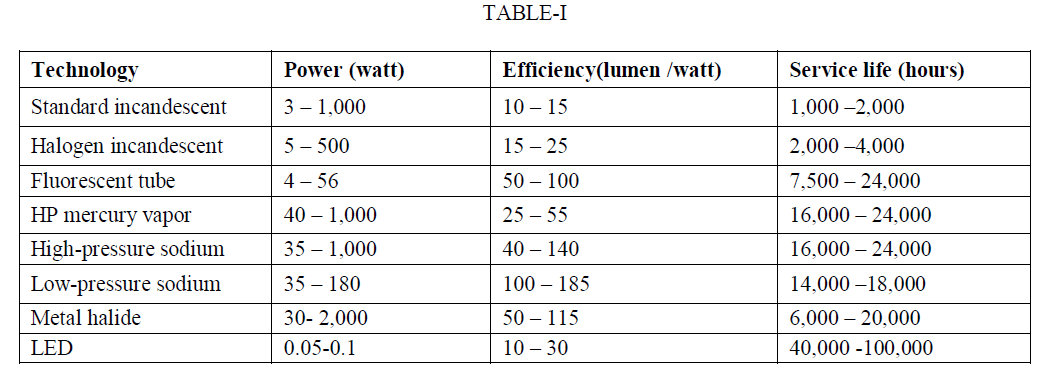 |
| Motors |
| To improve passive energy efficiency it is necessary to replace existing motors which are old and require rewinding. Correctly sized motors are preferred as oversized motors are more expensive and are sometimes less efficient than correctly sized motors. Efficiency declines rapidly when loads are below 30% [10]. The power factor drops drastically when the motor does not work at full load, which can lead to charges being levied for reactive power. Choosing an appropriate motor starter/controller and more expensive but more efficient motor can quickly be very profitable as energy costs account for over 97% of the lifecycle costs of a motor [10]. |
| However, before deciding whether to replace a motor, it is essential to take some points into consideration such as the motor’s remaining life cycle, expense of replacing a motor even if it is clearly oversized and may not be justified if its load is very small or if it is only used infrequently and ensure that the new motor’s critical performance characteristics such as speed are equivalent to those of the existing motor. |
| Reflectors |
| A less common passive energy efficiency measures is to replace the reflectors diverting light to areas where it is needed. Advances in materials and design have resulted in better quality reflectors which can be fitted to existing lights.These reflectors intensify useful light, so that fewer lights may be required in some cases. Energy can be saved without having to compromise on lighting quality. New, high-performance reflectors offer a spectral efficiency of over 90% [10]. This means two lights can be replaced by a single light, with potential savings of 50% or more in terms of the energy costs associated with lighting. Existing luminaries can be retrofitted by installing mirror-type reflectors without having to adjust the distance between them. This has the advantage of simplifying the retrofitting process and reducing the work involved, with minimal changes made to the existing ceiling design. |
| 2. The final stage consists of implementing basic changes, introducing automation and putting in place an infrastructure based around monitoring, support and continuous improvement. |
| Monitoring systems |
| As electrical networks are developing rapidly, a system for monitoring the transfer and consumption of energy is able to provide all the information needed to carry out a full audit of the site. As well as this audit would cover water, air, gas and steam measurements. Comparative analyses and standardized energy consumption data can be used to determine the efficiency of processes and industrial installations. These include control and automation systems for lighting and buildings, variable speed drives and process automation. Recording information on effective equipment make it possible to determine accurately the available capacity and requirement. Such as |
| (i)Timers to turn off lights after a certain period have passed. These are best used in areas where the typical time spent or period of activity is clearly defined such as corridor. |
| (ii) Movement sensors to turn off lights when no movement has been detected for a certain period. |
| (iii)Photoelectric cells/daylight harvesting sensors to control lights near windows. When sufficient daylight is available, lights are turned off or switched to night-light mode. |
| (iv) Programmable clocks to switch lights on and off at predetermined times such as shop fronts, office lights at nights and weekends. |
| (v)Dimmable lights to provide a low level of illumination at night light during off-peak periods e.g. a car park requiring full illumination until midnight, but where lower levels will suffice between midnight and dawn. |
| (vi)Voltage regulators, ballasts or special electronic devices to optimize energy consumption for lights such as fluorescent tubes, high-pressure sodium lights. |
LOAD MANAGEMENT |
| A successful demand response program works to level or smooth out the demand over the day without decrease in energy consumption. Demand response can be accomplished by developing time of day energy pricing schemes that provide incentives for customers to shift all or part of their load demand from peak to lower load periods. Load Management can be done by peak clipping, valley filling or load shifting. In Load shifting peak period loads are shifted to off-peak hours. Measures are related to heating and air-conditioning. This management strategy is an option for companies able to benefit from lower rates by scheduling consumption for all their processes where time of day is neither important nor critical. Load management programs can be effective in reducing peak demand, which in turn helps to reduce utility construction costs as well as lower electric rates. |
| Effects on Load Shapes: In this paper, different daily load curves of different load sectors are obtained from the data [11] is shown in this section. For applying load shifting, the on-peak and off-peak hours are to be determined by the pre-specified peak load and the valley load values respectively. The energy reduced during a day is shifted to the immediately following off-peak hours. From these load curves it is possible to modify the sector loads according to the sector load profile by applying load shifting to the different load sectors. |
| A. Industrial Sector: Fig.1 shows load profile of each day of a week. The shape of demand curves does not change much throughout the day, it shows straight line load curve for industrial sector. But Load demand on each day changes throughout the week. From fig.1 it can be seen that the load on holiday such as Wednesday is lower than working day. In case of Industrial sector the demand curve does not change and in Industries end use requirement is high ,it is possible to apply load shifting effectively. |
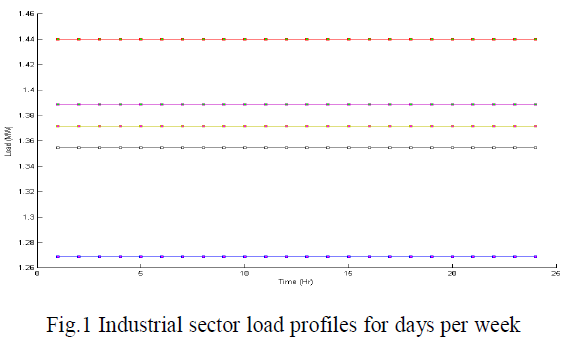 |
| B. Residential Sector: Fig. 2 shows a 24-h system residential sector load. It can be seen from this fig.2 that the peak hours are from 9.00 to 12.00 and from 18.00 to 20.00. The peak hours are much less than those of the large user sector. Residential Sector mainly consist of load such as Space heating, lighting, cooking appliances, water heater and air conditioner. The shares by different end-use categories varies among countries, but the variation is the greatest between water heating and air cooling appliances during coldest and hottest month of the year. In case of residential sector load shifting is not much effective because of low end use requirement. |
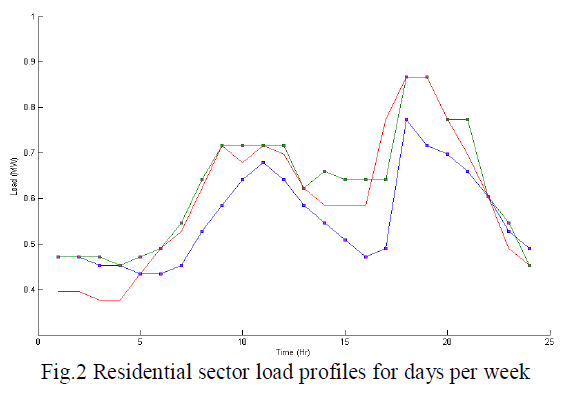 |
| C. Commercial sector: Fig.3 shows load curve of 24-h system of commercial sector such as shopping mall or Theaters. Time of peak load in the day is 17:00-22:00 and especially from Monday to Friday peak demand per day is around 0.3 MW. However, on Weekend load Demand is Maximum up to 0.44 MW. DSM can be achieved in case of commercial sector by applying load shifting measures and providing incentives to customers during off peak hours specially on working days. |
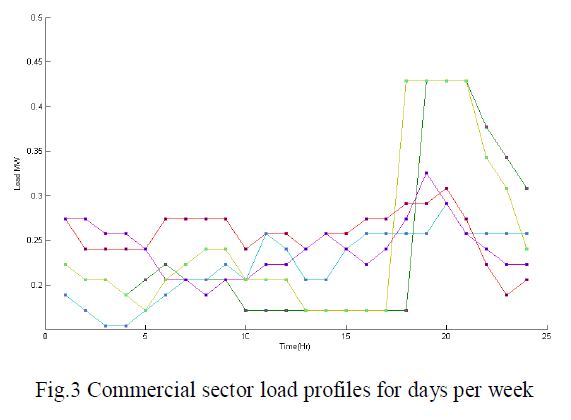 |
| D. Agriculture Sector: The demand of energy in this sector is increasing rapidly Fig.4 shows 24-h period system for agricultural sector loads of different feeder. The agricultural sector loads are seasonally dependent. The agricultural sector load during the hours of 8.00 to 18.00 is shown in fig.4.The energy during the peak hours can be reduced by shifting to the valley hours. It is possible to apply load shifting on agriculture sector easily by running water pumps in off peak hours and distribution companies should provide incentives for that to the farmers. |
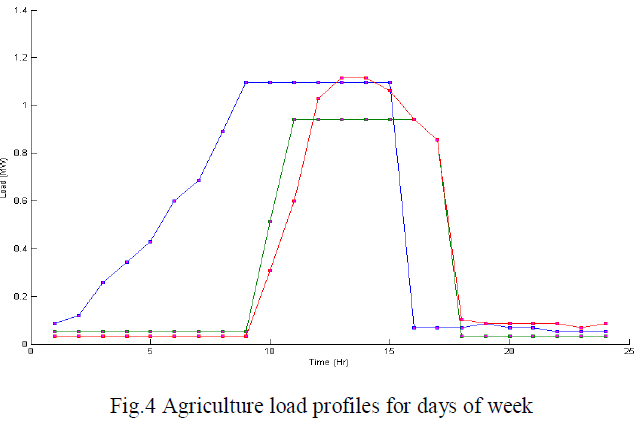 |
| This management policy is typically used during the hottest or coldest months of the year when companies and private customers have very high requirements for ventilation, air conditioning and heating, and when electricity consumption exceeds normal demand considerably. Reducing consumption in this way can prove problematic in residential and service sector environments, as there may be considerably inconvenience for building occupants. Customers from industrial sector may show more of an interest in this type of scheme and could benefit from contracts reducing unit costs by up to 30% if they have a high number of non-essential loads. |
CONCLUSION |
| In this paper some DSM measures have been suggested at consumer end to conserve the energy by applying load shifting on various power sector and by energy conservation methods. If followed, these measures would definitely help to reduce the gap between demand and supply. A successful load shifting program works to level or smooth out the demand over the day without decrease in energy consumption and it can be accomplished by developing time of day energy pricing schemes that provide incentives for customers to shift all or part of their load demand from peak to off peak hours. In this paper load curves of different load sector are obtained and from these load curves it becomes easy to apply load shifting from peak to off-peak hours. Energy conservation can be accomplished by replacing inefficient equipment by efficient one where system is used at its optimum level. |
References |
|